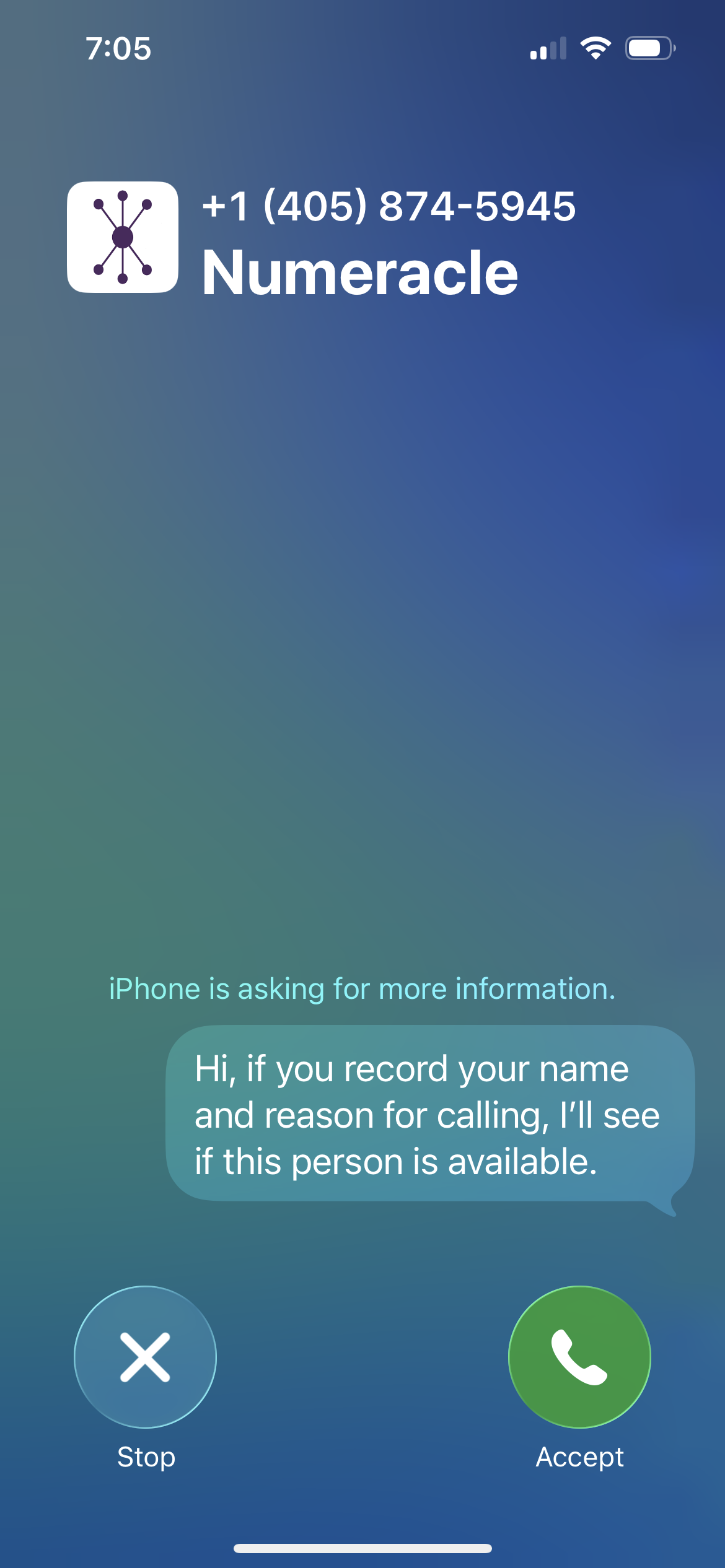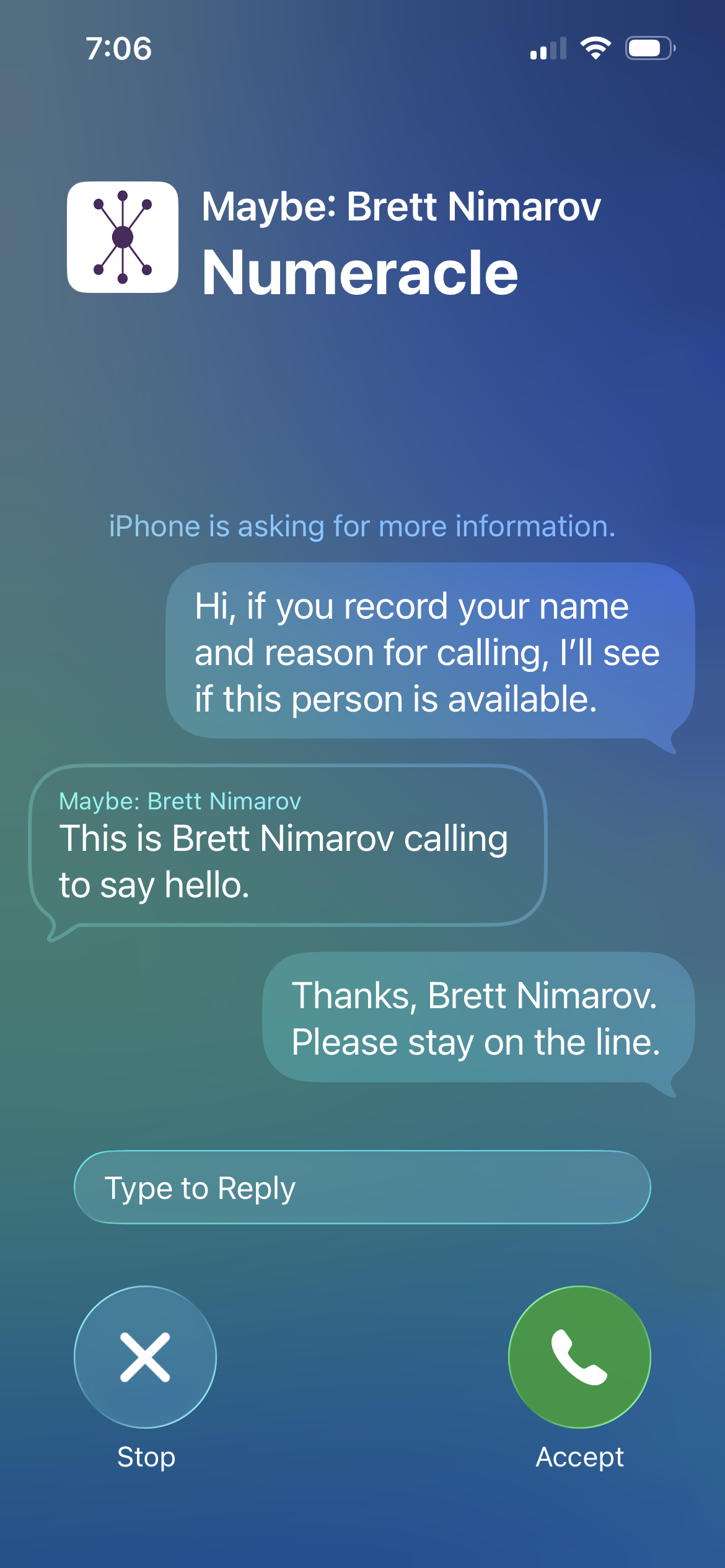Written by
Mary Gonzalez, Director of Brand & Content
Published on
October 29, 2025
Updated on
November 5, 2025

With Apple’s iOS 26 update introducing a new, more interactive call screening experience, Numeracle’s latest testing has confirmed something significant: when calls are delivered through CTIA’s Branded Calling IDTM (BCID) solution, the verified brand identity, including a caller name, logo, and reason for calling, continues to display seamlessly through the screening interface, even if the call is screened and new information is input.
This outcome reinforces what the industry has been working toward for years: a trusted, standards-based method of brand display that works with the device experience, not against it.
As an Authorized Vetting and Onboarding Partner helping to define the standards for the BCID ecosystem, Numeracle is proud to see our long-standing Know Your Customer (KYC) practices reflected in this evolution of authenticated, in-band branded calling. The fact that these principles are being validated in real-world environments like iOS 26 is both exciting and affirming. It’s a testament to how secure, verified identity can (and should) persist from call origination to consumer display. It’s reinforcement that industry standards built on verification and cryptographic integrity are the right path forward for the future of branded communications.
Unlike legacy methods of branding, BCID focuses on the vetting and security aspects of phone calls. Only calls that have been vetted, onboarded, and cryptographically signed end-to-end are delivered with verified brand identity, ensuring that branded information is both visible and trustworthy.
Another key advantage of BCID is that branded elements, including a verified logo, are displayed natively on the device. In iOS 26, this continues to function seamlessly within the call screener interface, making branded calls even more visible and recognizable during the screening process.
Testing with the iOS 26 developer beta revealed positive results for verified BCID calls: verified identity elements remain intact despite the iOS call screening prompt and interface.


This branded display reinforces BCID’s position as the industry-backed method for delivering authenticated branded calls that allows verified identity elements to remain intact within iOS 26 call screening interactions.
As the BCID ecosystem continues to expand, the early validation seen through platforms like iOS 26 is a strong indicator that authenticated identity is not only viable but essential for the future of trusted calls. This is a clear validation of how verified identity should behave, giving users visibility and choice, while preserving the integrity of legitimate communications.
For enterprises and contact centers, BCID represents more than just brand recognition or enhancement. It’s a practical solution for maintaining trust and visibility despite device-level features to ensure that legitimate calls continue to connect, even as consumers gain more control over which calls they answer.
Enterprises can access BCID today if their Originating Service Provider (OSP) is authorized to participate in the BCID ecosystem. If your telco provider is a BCID Authorized OSP, Numeracle’s Secure Verified Identity Presentation (sVIP) solution can help your OSP onboard, vet, and deliver your brand identity to consumers. If your OSP isn’t yet part of the BCID ecosystem, we can help you navigate the path to adoption.
Contact Numeracle to learn how to deliver your verified identity into the BCID Ecosystem through sVIP and preserve your visibility in the ever-changing world of software updates today, and in iOS releases to come.
Branded calling, also known as branded caller ID, is a technology that allows businesses to display branded assets on the recipient's phone screen when making outbound calls. This goes beyond the traditional Caller ID Name (CNAM), which typically only shows a phone number and sometimes a name.
Branded Calling works through various technical implementations, often involving third-party providers and integrations with the telecommunications network. When an outbound call is placed from your registered number, the Branded Calling service queries a database to retrieve your associated business branded assets, which is then transmitted to the recipient's device (if their device and carrier support the technology).
By providing clear and recognizable caller identification, Branded Calling significantly improves transparency and can combat the negative perception often associated with unknown or unidentifiable calls, ultimately strengthening your brand image and call engagement.
Inconsistencies in your branded call display often stem from inaccuracies or outdated information within the underlying Caller Name Presentation (CNAM) databases, which can be fragmented and lack real-time updates. Errors during the setup and transmission of your verified branded assets, coupled with variations in how carriers and devices interpret and display this information, can also lead to incorrect branding. Furthermore, if your number suffers a poor reputation and is flagged as spam, these warnings can supersede your intended branded display.
T-Mobile and Verizon support the delivery of Branded Calling IDTM (BCID TM) calls, with additional major U.S. mobile carriers expected to follow in 2026.